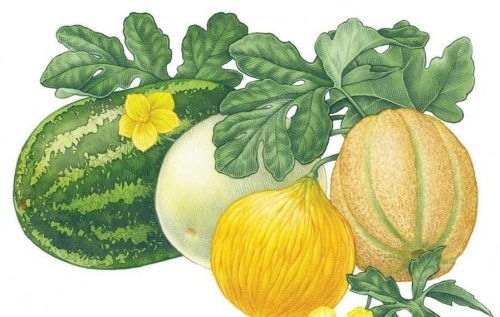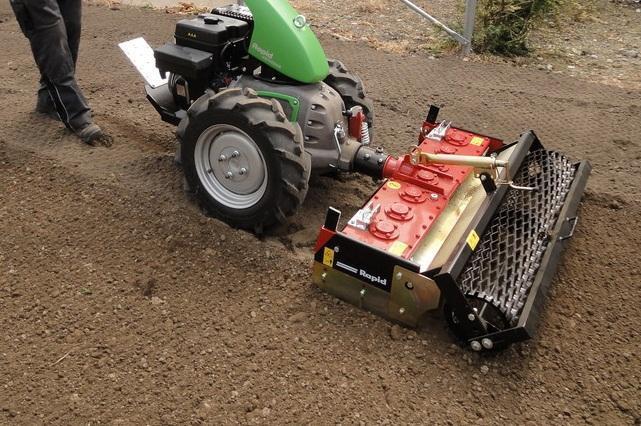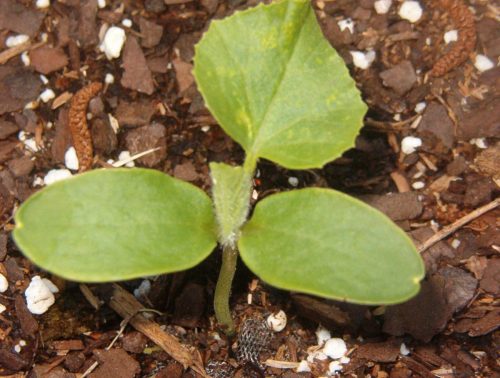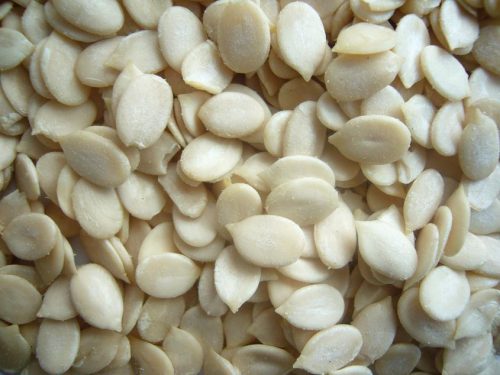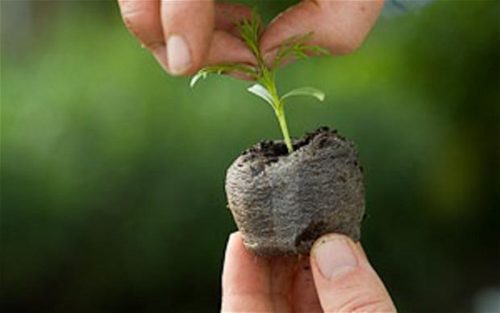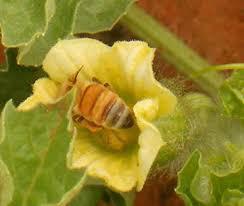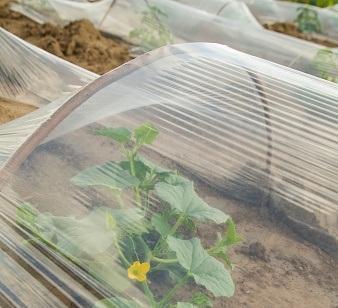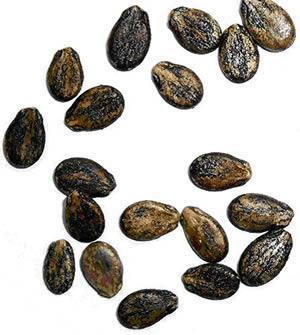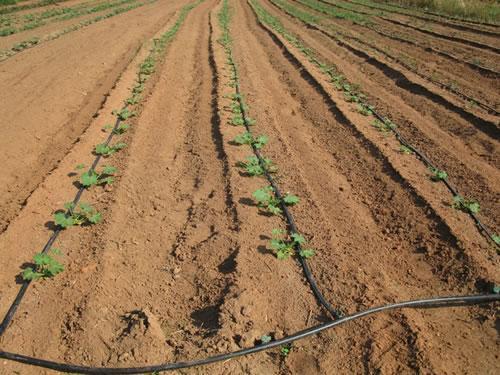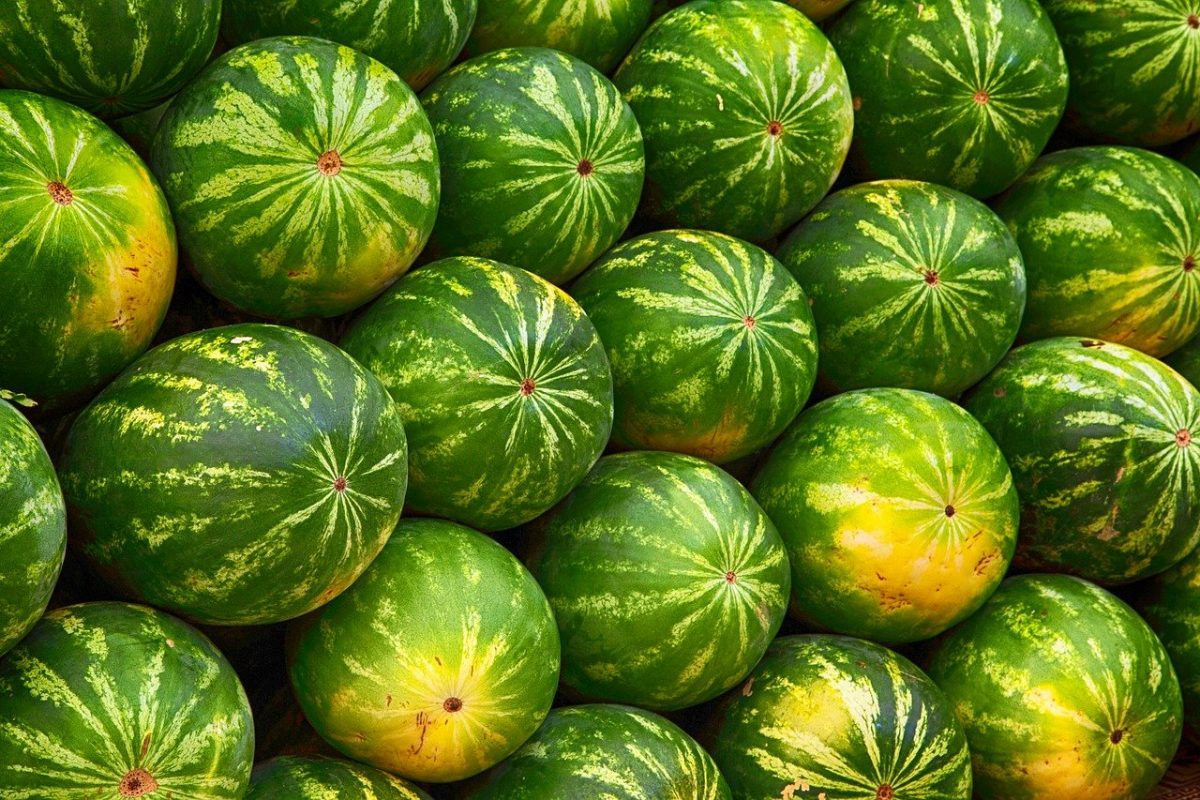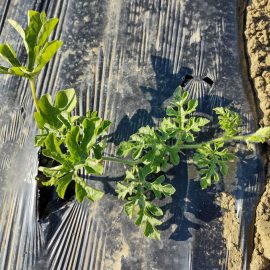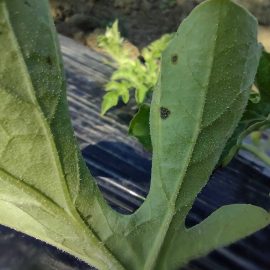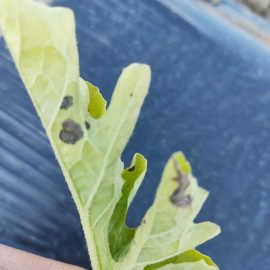Melons, information about crop management
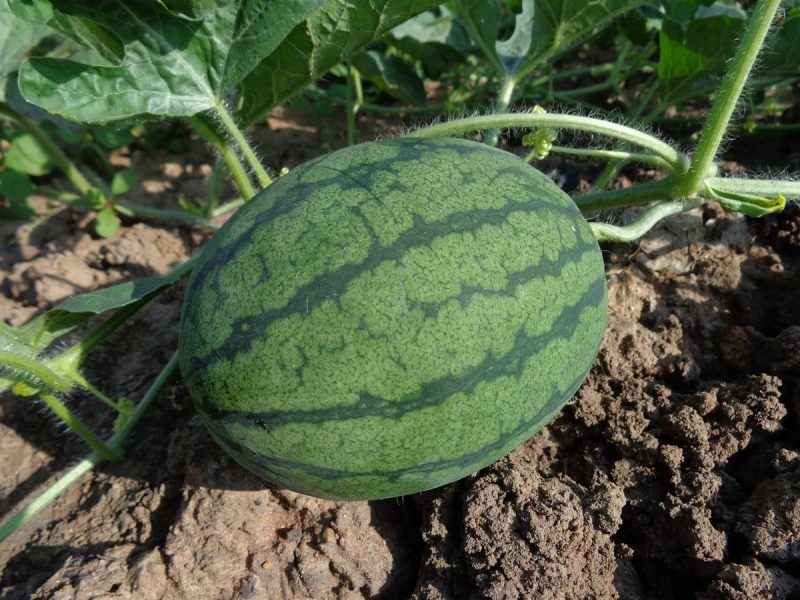
Melons (yellow – Cucumis melo and watermelon – Citrullus vulgaris) are cultivated for their fruits that are consumed at physiological maturity, fresh or prepared. Melon fruits are appreciated for their fine, refreshing, sweet, and pleasant taste. They contain sugar, vitamins, minerals, water, and protein.
Melon is native to Asia, Africa, and Afghanistan. It has been cultivated for about 2000 years. In Europe, it spread in the 15th century to the southern countries, then to France and Belgium. Melon is native to Central and South Africa. It has been cultivated since ancient times due to its high water content, by the Chinese, Indians, Arabs, and Egyptians.
Melon is an annual herbaceous plant. The root is developed and can reach 1 m in length. The stem is creeping, with rounded edges, its length can reach 4-5 m and is covered with fine hairs. The leaves are petiolate, palmately with elongated lobes, covered with fine hairs. The flowers are unisexual, elongated, yellow. The male flowers appear first in the axils of the leaves, 3-5 at a time. Females appear on secondary shoots. Pollination is entomophilic. The fruit is a melon of different shapes, sizes, and colors. The seeds are found inside the fruit.
Watermelon is an annual herbaceous plant with a strong root system that penetrates the soil to a depth of 1.5 m. The stem is creeping, strongly branched, 4-5 m long. The leaves are large, deeply septate, and covered with gray hairs. The flowers are large unisexual, and the female ones predominate. The fruit is a green melon with different designs. The seeds are large and of different colors.
Climate and soil requirements
Melons have high-temperature requirements. Optimum growing temperatures should be between 25°C and 30°C. Plants grow and develop well in the early stages of growth at temperatures above 15°C. They are affected by temperatures below 10°C. Large temperature fluctuations during the flowering period cause flower abortion. Pollination and fertilization are best at temperatures above 20°C.
Melons are sensitive to draughts, so it is recommended to surround the crop with protective curtains. A few rows of tall plants can be planted at the edge of the plot. Examples: maize, sorghum, or sunflowers. Melons also have high light requirements. They need about 1500 hours of sunshine throughout the growing season. Bright light favorably influences the sugar accumulation in melon fruits, and the lack of it delays ripening. The water deficit in the soil is compensated for by the root system, which has a high power of soil exploration. However, 2-3 waterings result in significant yield increases. The plant prefers light, fertile soils with a pH between 6 and 7.2.
Cultivation
Melons cultivation
Crop rotation. Melons can be grown after cereals, maize, perennial legumes (clover, alfalfa), onions, garlic, potatoes, beans, peas, and radishes. These crops leave the soil weed-free and well-structured. On a plot where melons, cucumbers, zucchini, or other cucurbits have been grown, melons can return after 3-4 years.
Soil preparation
This stage starts in the autumn by clearing the land of the pre-emergent crop. Basic fertilization is carried out after a preliminary soil analysis. After application of basic fertilization, the soil is tilled to a depth of 28 – 30 cm.
In spring, fertilization can be supplemented with specific fertilizers and the soil can be shaped into ridges or raised beds. If you grow melons in an intensive system and use drip irrigation, it is best to install the system together with the soil cover. A pre-emergence herbicide can be applied before sowing or immediately after sowing, following the specifications of the product chosen.
Recommended products
-
You can find products on a different store
Change Store -
You can find products on a different store
Change Store -
You can find products on a different store
Change Store -
You can find products on a different store
Change Store -
You can find products on a different store
Change Store -
You can find products on a different store
Change Store -
You can find products on a different store
Change Store -
You can find products on a different store
Change Store -
You can find products on a different store
Change Store -
You can find products on a different store
Change Store -
You can find products on a different store
Change Store -
You can find products on a different store
Change Store -
You can find products on a different store
Change Store -
You can find products on a different store
Change Store -
You can find products on a different store
Change Store -
You can find products on a different store
Change Store -
You can find products on a different store
Change Store -
You can find products on a different store
Change Store -
You can find products on a different store
Change Store -
You can find products on a different store
Change Store -
You can find products on a different store
Change Store -
You can find products on a different store
Change Store -
You can find products on a different store
Change Store -
You can find products on a different store
Change Store
Planting
Melons are grown from seedlings (for earlier production) or seeds. Seedlings are obtained by sowing directly into Rockwool cubes or on soil mix. Sowing takes place in March. Sowing to produce seedlings takes place in March.
Recommended products
-
You can find products on a different store
Change Store -
You can find products on a different store
Change Store -
You can find products on a different store
Change Store -
You can find products on a different store
Change Store -
You can find products on a different store
Change Store -
You can find products on a different store
Change Store -
You can find products on a different store
Change Store -
You can find products on a different store
Change Store -
You can find products on a different store
Change Store -
You can find products on a different store
Change Store -
You can find products on a different store
Change Store -
You can find products on a different store
Change Store -
You can find products on a different store
Change Store -
You can find products on a different store
Change Store -
You can find products on a different store
Change Store -
You can find products on a different store
Change Store -
You can find products on a different store
Change Store -
You can find products on a different store
Change Store -
You can find products on a different store
Change Store -
You can find products on a different store
Change Store -
You can find products on a different store
Change Store -
You can find products on a different store
Change Store -
You can find products on a different store
Change Store -
You can find products on a different store
Change Store
It is recommended to use a special substrate to produce seedlings. The mixture must be treated with specific products to prevent certain diseases/pests from occurring.
Recommended products
-
You can find products on a different store
Change Store -
You can find products on a different store
Change Store -
You can find products on a different store
Change Store -
You can find products on a different store
Change Store -
You can find products on a different store
Change Store -
You can find products on a different store
Change Store -
You can find products on a different store
Change Store -
You can find products on a different store
Change Store -
You can find products on a different store
Change Store -
You can find products on a different store
Change Store -
You can find products on a different store
Change Store -
You can find products on a different store
Change Store -
You can find products on a different store
Change Store -
You can find products on a different store
Change Store -
You can find products on a different store
Change Store -
You can find products on a different store
Change Store -
You can find products on a different store
Change Store -
You can find products on a different store
Change Store -
You can find products on a different store
Change Store -
You can find products on a different store
Change Store -
You can find products on a different store
Change Store -
You can find products on a different store
Change Store -
You can find products on a different store
Change Store -
You can find products on a different store
Change Store
Ideally, only one seed should be sown in a nest. If more than one seed is sown, when the seedlings are planted and separated, the roots can be damaged and the seedling suffers shock, which can lead to plant loss. Seedlings need a vegetative treatment before planting with specific fungicides to prevent damping-off.
Recommended products
-
You can find products on a different store
Change Store -
You can find products on a different store
Change Store -
You can find products on a different store
Change Store -
You can find products on a different store
Change Store -
You can find products on a different store
Change Store -
You can find products on a different store
Change Store -
You can find products on a different store
Change Store -
You can find products on a different store
Change Store -
You can find products on a different store
Change Store -
You can find products on a different store
Change Store -
You can find products on a different store
Change Store -
You can find products on a different store
Change Store -
You can find products on a different store
Change Store -
You can find products on a different store
Change Store -
You can find products on a different store
Change Store -
You can find products on a different store
Change Store -
You can find products on a different store
Change Store -
You can find products on a different store
Change Store -
You can find products on a different store
Change Store -
You can find products on a different store
Change Store -
You can find products on a different store
Change Store -
You can find products on a different store
Change Store -
You can find products on a different store
Change Store -
You can find products on a different store
Change Store
A good quality seedling should be 40-50 days old. When the plants have 4-5 leaves, pinch off the tops. This way, the seedlings already have 2-3 viable shoots when planted. Before planting, the seedlings should be watered abundantly. Planting of seedlings in the field can be done manually or semi-mechanically (in large areas) when climatic conditions are optimal.
If the crop is established by seeds, sowing begins when, in the soil, at a depth of 8 – 10 cm there are temperatures of 12 – 13 ° C with a tendency to rise. The operation can be done manually or mechanized. The distance between rows is 150 cm, and the distance between plants per row is 22-26 cm. The sowing depth is 3-4 cm and approximately 3-5 kg seed/ha is used.
Pest and disease control
Control is achieved by applying specific fungicide and insecticide treatments. To avoid the appearance of diseases or pests resistant to pesticides, it is recommended to alternate products with different active substances.
Weed control
It is recommended to carry out 3 – 4 manual or mechanized hoeings, without damaging the plant stems. Weeds can also be controlled chemically by applying herbicides.
Recommended products
-
You can find products on a different store
Change Store -
You can find products on a different store
Change Store -
You can find products on a different store
Change Store -
You can find products on a different store
Change Store -
You can find products on a different store
Change Store -
You can find products on a different store
Change Store -
You can find products on a different store
Change Store -
You can find products on a different store
Change Store -
You can find products on a different store
Change Store -
You can find products on a different store
Change Store -
You can find products on a different store
Change Store -
You can find products on a different store
Change Store -
You can find products on a different store
Change Store -
You can find products on a different store
Change Store -
You can find products on a different store
Change Store -
You can find products on a different store
Change Store -
You can find products on a different store
Change Store -
You can find products on a different store
Change Store -
You can find products on a different store
Change Store -
You can find products on a different store
Change Store -
You can find products on a different store
Change Store -
You can find products on a different store
Change Store -
You can find products on a different store
Change Store -
You can find products on a different store
Change Store
Care works
If the crop is established by direct seeding and the plants have 2 true leaves, they should be thinned. One or two plants should remain in the nest.
When the plants have 4 – 5 leaves, pinch the top of the plant to stimulate fruiting. The first 50 cm of the stem can be pruned back leaving only the female flower-bearing leaves. The female flowers have an ovary in the shape of the future fruit. After the flowers have formed fruit, and the fruit is the size of a walnut, the sterile shoots should be pinched off or removed completely. When the fruits are visible, the fruit should be thinned. Between 5 and 8 fruits can be left on a plant. The plant will then produce fruit of superior quality. Melon does not form seedless fruit.
Melons have a well-developed root system. It can explore a large mass of soil. But for considerably higher yields irrigation is recommended. The best irrigation method is drip irrigation. If you do not have this system, you can apply irrigation by furrow or row spacing. You can apply 2-3 irrigations with a norm of 250 – 300 m3/ha. Sprinkler irrigation is not recommended because water droplets are vectors for plant pathogenic (disease-causing) micro-organisms. During the fruit ripening period, irrigation should not be applied because the fruit may crack.
Pollination
Melon flowers open in the morning and close towards the afternoon. They need several visits by bees for pollination to be complete. Pollination usually takes place in the morning when the flowers are open and the pollen is viable. The process is usually completed around midday. In areas with high temperatures and low air humidity, pollen is only viable in the early morning. To not disturb pollinators’ activity, it is recommended that maintenance work and phytosanitary treatments be carried out in the evening or after lunchtime (during the flowering period). Supplementary pollination can be used by placing 3 hives per hectare of crop.
For intensive cultivation, it is recommended to apply 2 – 3 fertilizations, starting with vine formation. It can be applied NPK complex fertilizers and foliar fertilization for optimal micro-nutrient supply.
Recommended products
-
You can find products on a different store
Change Store -
You can find products on a different store
Change Store -
You can find products on a different store
Change Store -
You can find products on a different store
Change Store -
You can find products on a different store
Change Store -
You can find products on a different store
Change Store -
You can find products on a different store
Change Store -
You can find products on a different store
Change Store -
You can find products on a different store
Change Store -
You can find products on a different store
Change Store -
You can find products on a different store
Change Store -
You can find products on a different store
Change Store -
You can find products on a different store
Change Store -
You can find products on a different store
Change Store -
You can find products on a different store
Change Store -
You can find products on a different store
Change Store -
You can find products on a different store
Change Store -
You can find products on a different store
Change Store -
You can find products on a different store
Change Store -
You can find products on a different store
Change Store -
You can find products on a different store
Change Store -
You can find products on a different store
Change Store -
You can find products on a different store
Change Store -
You can find products on a different store
Change Store
Harvesting
The optimum harvest time is indicated by:
- the presence of the specific smell;
- change in fruit color;
- the appearance of slight cracks in the peduncle;
- the fruits are heavy;
- when tapped, the fruit should not sound hollow.
Harvesting starts in July (extra early varieties) and lasts until September. There are varieties with post-ripening potential. In this case, harvesting takes place a few days before the specific signs mentioned above appear.
Watermelons cultivation
Crop rotation. Watermelons can be grown after cereals, maize, perennial legumes (clover, alfalfa), onions, garlic, potatoes, beans, peas, and radishes. These crops leave the soil weed-free and well-structured. On a plot where melons, cucumbers, zucchini, or other cucurbits have been grown, watermelons can return after 3-4 years.
Soil preparation
This stage starts in the autumn by clearing the land of the pre-emergent crop. Basic fertilization is carried out after a preliminary soil analysis. After application of basic fertilization, the soil is tilled to a depth of 28 – 30 cm.
In spring, fertilization can be completed depending on the state of the soil supply. Before sowing or immediately after sowing, a pre-emergence herbicide can be applied, respecting exactly the specifications of the chosen product. The soil can be shaped into ridges or raised layers, or it can be covered with polyethylene foil. If you grow watermelons intensively and use drip irrigation, it is a good idea to install the system once the soil is covered with foil.
Recommended products
-
You can find products on a different store
Change Store -
You can find products on a different store
Change Store -
You can find products on a different store
Change Store -
You can find products on a different store
Change Store -
You can find products on a different store
Change Store -
You can find products on a different store
Change Store -
You can find products on a different store
Change Store -
You can find products on a different store
Change Store -
You can find products on a different store
Change Store -
You can find products on a different store
Change Store -
You can find products on a different store
Change Store -
You can find products on a different store
Change Store -
You can find products on a different store
Change Store -
You can find products on a different store
Change Store -
You can find products on a different store
Change Store -
You can find products on a different store
Change Store -
You can find products on a different store
Change Store -
You can find products on a different store
Change Store -
You can find products on a different store
Change Store -
You can find products on a different store
Change Store -
You can find products on a different store
Change Store -
You can find products on a different store
Change Store -
You can find products on a different store
Change Store -
You can find products on a different store
Change Store
Planting
The crop is established by seed or from seedlings (for early production). Sowing takes place in March, and 2 kg of seed is needed per hectare of crop. Sowing to produce seedlings takes place in March. A special mixture can be used as a substrate for seed production. The mixture is treated with specific products to prevent the appearance of diseases/ pests. Ideally, only one seed should be sown in a nest. If more than one seed is sown, when the seedlings are planted and separated, the roots may be damaged.
Seedlings need a vegetative treatment before planting with specific fungicides to prevent damping-off.
Recommended products
-
You can find products on a different store
Change Store -
You can find products on a different store
Change Store -
You can find products on a different store
Change Store -
You can find products on a different store
Change Store -
You can find products on a different store
Change Store -
You can find products on a different store
Change Store -
You can find products on a different store
Change Store -
You can find products on a different store
Change Store -
You can find products on a different store
Change Store -
You can find products on a different store
Change Store -
You can find products on a different store
Change Store -
You can find products on a different store
Change Store -
You can find products on a different store
Change Store -
You can find products on a different store
Change Store -
You can find products on a different store
Change Store -
You can find products on a different store
Change Store -
You can find products on a different store
Change Store -
You can find products on a different store
Change Store -
You can find products on a different store
Change Store -
You can find products on a different store
Change Store -
You can find products on a different store
Change Store -
You can find products on a different store
Change Store -
You can find products on a different store
Change Store -
You can find products on a different store
Change Store
A good quality seedling should be 40-50 days old. When the plants have 4-5 leaves, pinch off the tops. This way, the seedlings already have 2-3 viable shoots when planted. Before planting, the seedlings should be watered abundantly. Planting of seedlings in the field can be done manually or semi-mechanically (in large areas) when climatic conditions are optimal.
Recently, new technologies have been developed that determine the greater resistance of plants to pedoclimatic conditions. One of these methods is grafting. The grafted plants produce fruits with a firmer pulp, with a more intense color, which keeps their qualities longer. The grafted watermelon produces more fruit per plant. grafting methods are by insertion, splitting, and joining.
If the crop is established by seed, sowing starts when the soil temperature is above 15°C. The operation can be done manually or mechanically, at a depth of 3 – 4 cm, using 4-5 kg seed/ha. It is possible to sow manually, in nests, 2-3 seeds per nest. The distance between rows is 200 cm and the distance between plants per row is 50 cm. The crop can be established by sowing in double-protected areas.
Pest and disease control
Control is achieved by applying specific fungicides and insecticide treatments. To avoid the appearance of diseases or pests resistant to pesticides, it is recommended to alternate products with different active substances.
Weed control
It is recommended to make 3-4 hoeings, without damaging the plant stems. After the first two hoeings, it is recommended to cover the vines with soil to avoid wind damage. Weeds can also be controlled chemically by applying herbicides.
Recommended products
-
You can find products on a different store
Change Store -
You can find products on a different store
Change Store -
You can find products on a different store
Change Store -
You can find products on a different store
Change Store -
You can find products on a different store
Change Store -
You can find products on a different store
Change Store -
You can find products on a different store
Change Store -
You can find products on a different store
Change Store -
You can find products on a different store
Change Store -
You can find products on a different store
Change Store -
You can find products on a different store
Change Store -
You can find products on a different store
Change Store -
You can find products on a different store
Change Store -
You can find products on a different store
Change Store -
You can find products on a different store
Change Store -
You can find products on a different store
Change Store -
You can find products on a different store
Change Store -
You can find products on a different store
Change Store -
You can find products on a different store
Change Store -
You can find products on a different store
Change Store -
You can find products on a different store
Change Store -
You can find products on a different store
Change Store -
You can find products on a different store
Change Store -
You can find products on a different store
Change Store
Care works
If the crop is established by direct seeding and the plants have 2 true leaves, they should be thinned. One or two plants should remain in the nest.
When the plants have 4 – 5 leaves, pinch the top of the plant to stimulate fruiting. The first 50 cm of the stem can be pruned, leaving only the female flower-bearing stems. After the fruit has formed and is the size of a walnut, the sterile shoots should be pinched off or removed completely. When the fruits are visible, the fruits should be thinned out. Between 4 and 5 fruits must be left on a plant. The plant will then produce fruit of superior quality. Watermelon can form a seedless fruit.
Melons have a well-developed root system. It can explore a large mass of soil. But for considerably higher yields irrigation is recommended. The best method of irrigation application for melons is drip irrigation. If you do not have this system, you can apply irrigation by furrow or row spacing. You can apply 2-3 irrigations with a norm of 250 – 300 m3/ha. Sprinkler irrigation is not recommended as it can encourage the development of plant diseases. During the ripening period, irrigation is not recommended because the fruit may crack.
Pollination
Watermelon flowers open in the morning and close towards the afternoon. They need several visits by bees for pollination to be complete. Pollination usually takes place in the morning when the flowers are open and the pollen is viable. The process is usually completed around midday. In areas with high temperatures and low air humidity, pollen is only viable in the early morning. To not disturb pollinators’ activity, it is recommended that maintenance work and phytosanitary treatments are carried out in the evening or after lunchtime (during the flowering period). Supplementary pollination can be used by placing 3 hives per hectare of crop.
For intensive cultivation, it is recommended to apply 2 – 3 fertilizations, starting with vine formation. It can be applied NPK complex fertilizers and foliar fertilization for optimal micro-nutrient supply.
Recommended products
-
You can find products on a different store
Change Store -
You can find products on a different store
Change Store -
You can find products on a different store
Change Store -
You can find products on a different store
Change Store -
You can find products on a different store
Change Store -
You can find products on a different store
Change Store -
You can find products on a different store
Change Store -
You can find products on a different store
Change Store -
You can find products on a different store
Change Store -
You can find products on a different store
Change Store -
You can find products on a different store
Change Store -
You can find products on a different store
Change Store -
You can find products on a different store
Change Store -
You can find products on a different store
Change Store -
You can find products on a different store
Change Store -
You can find products on a different store
Change Store -
You can find products on a different store
Change Store -
You can find products on a different store
Change Store -
You can find products on a different store
Change Store -
You can find products on a different store
Change Store -
You can find products on a different store
Change Store -
You can find products on a different store
Change Store -
You can find products on a different store
Change Store -
You can find products on a different store
Change Store
Harvesting
The optimal harvest time is indicated:
- the muffled sound when the fruit is hit with the finger;
- the peel acquires its characteristic shine;
- the peel is easy to scratch.
The fruit can be detached from the plant with a knife, without touching the vines. The fruit should be harvested only when it is ripe.














































































































































































































































































































































































































































